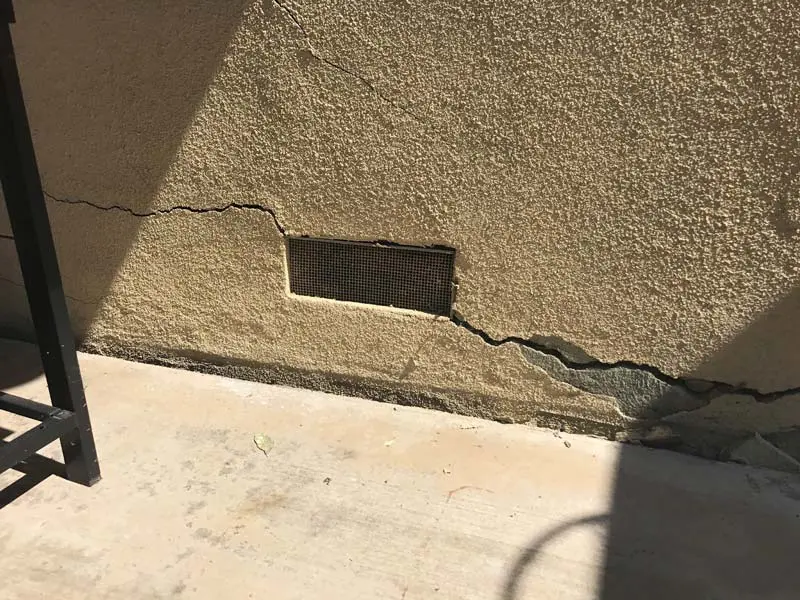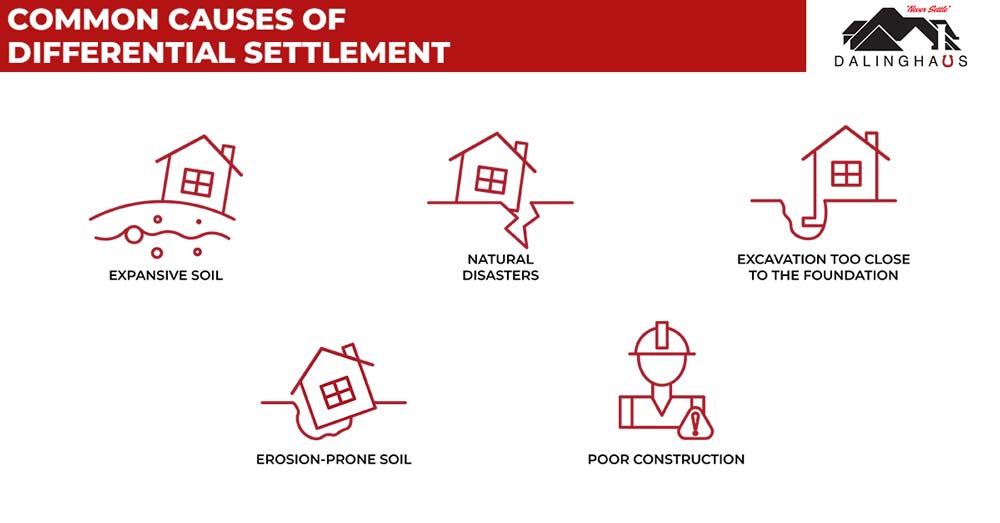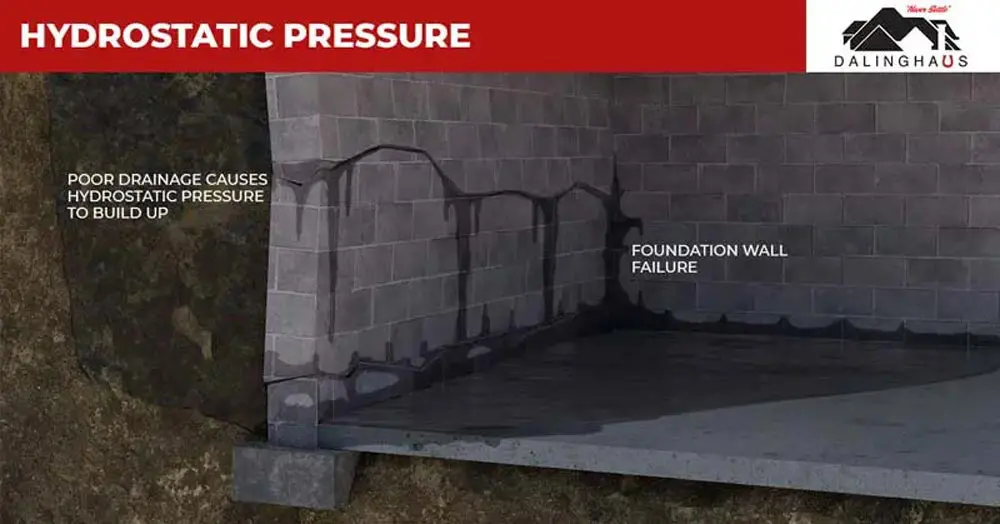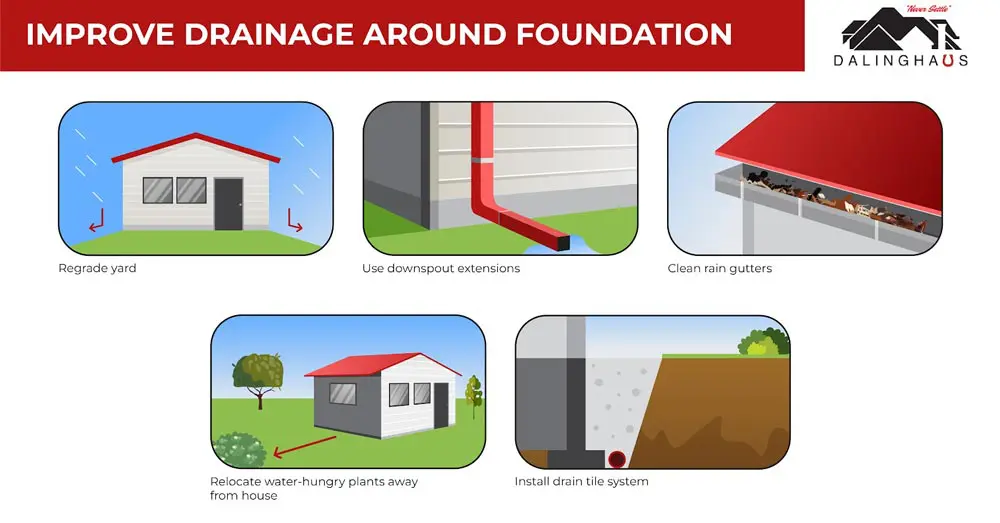Looking for information about fixing foundation cracks from the outside? If so, you’ve landed on the right page because that’s what we’re going to review in this article. We’ll review the types of foundation cracks, common causes, how to fix foundation cracks, and more.
The Two Most Common Causes Of Foundation Cracks

Most foundation cracks happen for two main reasons: differential settlement and hydrostatic pressure.
Differential settlement
All structures will settle into the ground slightly after they’re built. This is normal, and there is nothing to worry about as long as the settlement is uniform. Differential settlement – when a structure settles unevenly into the ground – is another matter. If it isn’t corrected, differential settlement can cause severe structural damage to a foundation.
So, what causes differential settlement?
Various things can cause differential settlement, including the following:
Expansive soil
Expansive soil contains a high percentage of clay, and because of this, it swells when exposed to water and shrinks when it loses moisture and dries out. This is usually a seasonal phenomenon that creates movement in the ground under the foundation as the soil swells and shrinks. Over time, this can lead to differential settlement and structural damage, manifesting as foundation cracks, uneven floors, and problems opening and closing doors and windows.
Erosion-prone soil
Other soil types can also cause differential settlement due to their tendency to erode over time. This can result in void-filled soil that cannot adequately support the foundation, leading to differential settlement.
Poor construction techniques
Soil must be adequately compacted before construction begins to remove air pockets and increase the soil’s density and strength. This step is crucial since uncompacted soil can cause numerous problems for a construction project, including differential settlement, as the structure settles unevenly into the ground after it’s built. Compaction ensures the soil can support the structure’s weight.

Excavation next to the foundation
If your neighbor digs a big hole too close to your house, it could destabilize the soil under the foundation and lead to differential settlement and structural damage.
Natural disasters
Earthquakes, floods, hurricanes, tornadoes, etc., can all cause differential settlement and severe foundation damage. For example, during an earthquake, the ground moves, and this can very easily result in differential settlement. Similarly, the soil can become saturated with water during floods, leading to instability under the foundation.
Hydrostatic pressure
If you live in a region of the country where basement foundations are common, cracks in a foundation wall are often caused by hydrostatic pressure that has built up in the ground around the foundation. Hydrostatic pressure exerts enormous pressure against foundation walls, and if it isn’t relieved, the foundation wall will eventually begin to bow inward. It could even crack. This compromises the structural integrity of the building and will require costly repairs.

What causes hydrostatic pressure?
Hydrostatic pressure builds up when excess moisture in the ground around the foundation can’t drain off. Hydrostatic pressure builds up because of poor drainage, in other words. Factors like high rainfall, poorly designed or no drainage systems, leaky plumbing, and low-lying areas prone to flooding can exacerbate hydrostatic pressure build-up.
Fixing Foundation Cracks From The Outside For Cracks Caused By Differential Settlement
Cracks caused by differential settlement are usually fixed from outside via a repair technique called underpinning. Underpinning involves excavating around the outside of the foundation down to the footing and then installing piers to extend the foundation down to load-bearing soil. Once the piers are in place, the foundation is raised as much as possible without causing damage. After underpinning, the cracks caused by the differential settlement will usually close.
Fixing Foundation Cracks From The Outside Is Not The Best Repair Solution For Cracks Caused By Hydrostatic Pressure
If you live in a region where basements are common and the cracks and/or bowing were caused by hydrostatic pressure, they are not fixed from the outside. They’re fixed from the inside using repair solutions such as carbon fiber straps and wall plate anchors. These stabilize the wall and prevent any further inward movement.
What About DIY Foundation Crack Repair?
Cracks caused by differential settlement or hydrostatic pressure should only be repaired by a professional foundation repair contractor. However, cracks that are merely cosmetic and not caused by a structural issue can often be repaired as a DIY project.
A word of caution: Unless you’re sure a crack is non-structural, contact a professional foundation repair contractor to evaluate it.
The Best Way To Prevent Foundation Cracks
Fortunately, there are ways homeowners can help prevent foundation cracks. Because water is a leading culprit behind the two main causes of foundation cracks – differential settlement and hydrostatic pressure – you can go a long way toward preventing trouble by controlling groundwater around the foundation. Here are some ways to do that:
- Clean gutters regularly – When gutters clog with dead leaves and other debris, water can overflow, run down the side of the house, and soak the ground around the foundation.
- Install downspout extensions – Downspout extensions are inexpensive and easy to install. They will ensure runoff is carried away from the foundation before release. Downspout extensions should be at least six feet long to be the most effective.
- Regrade the yard around the foundation, if necessary – It’s essential to ensure that the yard is sloped away from the house so that groundwater doesn’t drain toward the foundation.
- Consider relocating water-hungry vegetation – While flowers and shrubs may look nice planted next to the house, they need water. Consider relocating them several feet away from the foundation.
- Keep trees away from the foundation – Large trees with extensive root systems can invade the ground under the house and push against the foundation. Tree roots can also “drink” moisture from the soil, creating voids under the foundation.
- Install a drain tile system – Installing a drain tile system is a very effective way to prevent foundation cracks. It works by preventing excess moisture from building up in the ground around the foundation. Excess groundwater flows into a perforated drainage pipe (buried at the footing level) and toward a sump pit. Once the sump pit fills with water, a sump pump turns on and expels the water away from the foundation.

If you’re concerned about foundation cracks in your home, contact us today to schedule a foundation evaluation and receive a repair estimate. We serve Southern California, Arizona, and Nevada.






